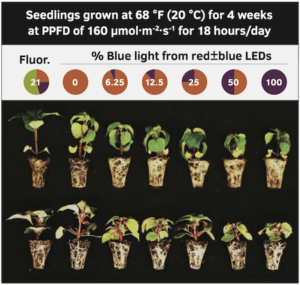Blue Light as a PGR
Plant growth retardants (PGRs) are commonly applied to floriculture crops, both during propagation and the growing out (finishing) phase. When properly used, PGRs are a safe and effective way to inhibit extension growth of a wide range of ornamental crops. It can be challenging, though, to identify a suitable chemical and concentration because the choice depends on the species (and sometimes cultivar), cultural conditions, environmental conditions, magnitude of the desired response, and, of course, active ingredient. With a few exceptions, PGRs cannot be applied to edible crops such as herbs and vegetables, so growers must use other techniques to control extension growth.
Blue light refers to photons with wavelengths between 400 and 500 nm. While species’ responses to different wavebands of light vary, blue light typically inhibits extension growth. More specifically, plants grown under more blue light usually have smaller and darker leaves and shorter internodes, creating a more compact plant (Figure 1). Therefore, in many respects, blue light can act as a PGR.
A common way to manipulate the greenhouse light environment is with supplemental lighting. When considering photosynthetically active radiation (400 to 700 nm), only 6% of light emitted by high-pressure sodium (HPS) fixtures is as blue light; the rest is as green and red light. Metal halide fixtures emit much more blue light (24%). The blue light fraction emitted by LED fixtures depends on the number of blue and/or white LEDs relative to red LEDs.
Conventional and LED lighting fixtures can be subjectively classified based on the percentage of light emitted as blue: 4 to 8% can be considered as low blue, 9 to 16% as medium blue, 17 to 24% as high blue, and 25% or higher as very high blue. In many cases, the percentage of light emitted by a lighting fixture as blue is not explicitly stated. However, it is a metric that lighting companies and their distributors should readily communicate when asked. Because of the effects of blue light on growth, the percentage of blue light emitted by a lighting fixture is one of several important metrics to consider when selecting a high-intensity lighting system.

The effects of the photon spectrum (light quality) on plant growth are more pronounced when plants are grown indoors, without the sun. Whether grown indoors or in greenhouses, responses to blue light are enhanced when plants are grown under low-light conditions, such as an average daily light integral of less than 10 mol∙m⁻²∙d⁻¹. Plants are often more compact when grown under high-light levels and, therefore, the effects of the photon spectrum are less when plants are grown under a moderate to high daily light integral.
In addition to blue light, other wavebands can also influence extension growth, especially far-red light (700 to 800 nm). Far-red light generally acts antagonistically to blue light; it typically increases extension growth. Therefore, depending on the crop, the effects of high blue light can be partly diminished by far-red light. The vast majority of LED products developed for supplemental (high intensity) greenhouse lighting emit very little far-red light (usually less than 2%). In contrast, HPS fixtures emit slightly more far-red light than blue light.
In addition to inhibiting extension growth, blue light can have other effects on crops. Probably the most visible effect is on increasing leaf pigmentation. Blue light increases the synthesis of secondary metabolites, some of which cause leaves to turn more purple in color. We have also seen decreased incidence of intumescence when plants are grown under a high percentage of blue light.
Blue light has relatively high energy, although our visual perception of blue light isn’t very good. In other words, a high intensity of blue light can still appear fairly dim. Because of this high energy yet poor visibility combination, we should not look directly at blue LEDs; doing so can cause eye strain or damage.


 Video Library
Video Library 




















